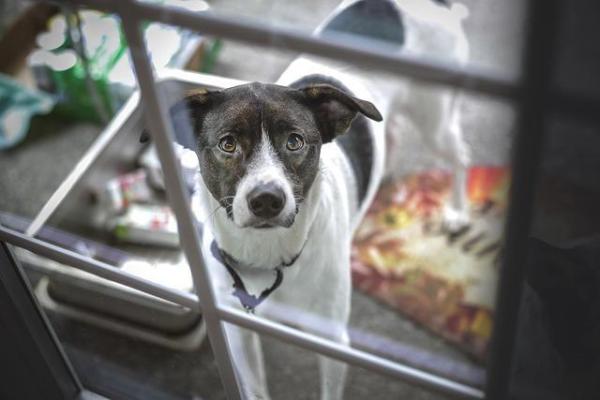Signs of Pain in Dogs



See files for Dogs
Watching our best animal friends behave strangely can cause us great worry. The thought of them feeling pain is a particular fear since we never want any harm to come to our dogs. Although canines don't have the ability to speak as humans do, they have forms of communication. These can be vocalizations, but are most commonly expressed through body language. A dog in pain is no exception. It is our duty as caregivers to learn how to read these messages and detect problems.
If you want to know how to know if a dog is in pain, you need to know what to look out for. This is why AnimalWised reveals the 5 signs of pain in dogs.
How to tell if a dog is in pain
A dog is often very good at hiding when they are in pain. While we can commend their bravery, this is actually quite unfortunate. It means a dog can be in serious levels of pain or distress without making it obvious to their caregiver. Although adept at masking pain, no dog will be able to hide it completely when they are in sufficient physical discomfort. They may not be easy to observe, but the signs will be present on some level.
Understanding when a dog is feeling pain means both observing their body language, as well as the context of the situation. Although dogs have certain body language signals common to all canines, they are also individuals. For example, a dog may become more sedentary when they are in pain. This will be easier to notice in a dog that is normally very active than in a dog which is already quite sedentary.
We also need to be aware of their actions and think back to anything that might have happened. For example, you may have heard the dog yelp while out on a walk, but not thought anything of it as the dog returned to normal behavior soon after. In this instance they could have received a bite or cut their paw, but we didn't pick up on it at the time.
The state of a dog will also help inform us if they might be in pain. Older dogs do not have the same immunity nor the physical strength as when they were younger. They are more susceptible to certain conditions such as ataxia in dogs which can be very painful. For this reason, we need to be observant for the most common signs of pain in dogs. Keep reading to find out what they are.
1. They pant excessively
Panting is a completely normal behavior in dogs, especially on those hot days or when you have been engaging in physically strenuous activities. Panting is a natural way for dogs to cool their bodies and cause their body temperature to decrease. This is because they do not have sweat glands on most of their body and use panting to thermoregulate themselves.
The problem is when this excessive panting comes out of nowhere. If you see that your dog is panting more than normal all of a sudden, it may be a clear sign that they do not feel right. It is likely they are going through an episode of stress or fear due to some pain. Some of the most serious health concerns which cause a dog to pant in pain are substance poisoning or heat stroke in dogs.

2. They isolate themselves
When we are in pain, we may want to call out for help or make sounds which attract attention. For dogs, the opposite is often true. When a dog is in pain, it is normal for them to isolate themselves, even from the people with whom they are closest. This is related to their wild ancestry. When a dog is sick or in pain, they are more vulnerable By hiding, they can protect themselves from predators who could otherwise take advantage of their weakened state.
Some dogs will want to protect themselves in a more aggressive manner. When they are in pain, they fear they will be killed or harmed further. This can be a common reason why a dog suddenly becomes aggressive. Even if we are close to them, the pain causes them fear and they may lash out.
If your dog has any pain you may notice that they begin to show a antisocial behavior such as not greeting your arrival home or avoiding any physical contact. They may even become aggressive. Always keep in mind that your dog is not trying to harm anyone or to be unfriendly, it is their way of saying that something hurts and that they prefer not to be touched.
3. Excessive licking
As with other daily routines, it is common for dogs to feel the need to clean themselves. In fact, they like to lick to both groom themselves and to feel calm. What is not normal is that they are doing it all obsessively all day.
Analyze your dog's behavior as they groom themselves when they are totally healthy and then stay alert to compare it. They may be experiencing some pain and to calm down they overly lick an area where they did not before. This is an action performed in the hope of cleaning and healing a wound, but it can also occur if they feel pain under the skin. We need to ve very careful in this case as excessive licking can cause issues such as acral dermatitis in dogs.
The area which the dog licks might inform us of the source of the pain. For example, a common reason a dog is in pain is due to trauma on their paws. If we see our dog continuously licking their paws, they may have cut themselves while walking or developed some kind of contact dermatitis reaction.
4. Appetite loss
We often do not want to eat when we are sick and a dog is very much the same. This is one of the primary reactions of their organism when a dog is experiencing some pain or illness. It could also be the case that your dog feels like eating, but walking to their dog bowl is too painful. In this case, try to bring the feed to their bed.
In spite of this, if your dog spends a lot of time without eating, they could be suffering from an illness, which does not necessarily have to be serious. Regardless, it must be evaluated during a visit to the vet. Some of the serious diseases that are detected through inappetence include canine anorexia, kidney or liver problems, systemic infections, dental diseases and even cancer in dogs.

5. General changes in behavior
If your dog was never very vocal, but is now barking all night long, they may be warning you that something hurts. Likewise, if your dog was rarely quiet but remains silent for most of the day, there will be an underlying issue. It is very important to know your dog, their dynamics, personality, likes and dislikes. This is the only way you can make the right comparisons to see if your best friend is going through some uncomfortable experience, has a wound or feels pain.
You could notice your dog is limping, or something much more subtle, for example, that they do not want to climb the stairs or go for the ball they like so much. Also one physical sign of pain is if they keep their torso arched or they are too tense.
Dogs that feel bad often lie on their side with their legs stretched out. This could be different than the way your pet sleeps every night. Maybe your dog is sleeping too much but still very active on walks, or your dog could move slowly and parsimoniously. There are thousands of behaviors that could be signs of pain in dogs. Each behavior is a warning and it is a warning we must heed.
If your dog is in pain due to an illness, they will also show certain specific sings. Below we share a video on the warning signs your dog is sick:

This article is purely informative. AnimalWised does not have the authority to prescribe any veterinary treatment or create a diagnosis. We invite you to take your pet to the veterinarian if they are suffering from any condition or pain.
If you want to read similar articles to Signs of Pain in Dogs, we recommend you visit our Prevention category.








